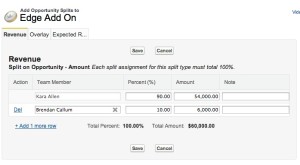Well, it’s official. With the Salesforce Summer ’14 release, Collaborative Forecasting is all grown up and has far surpassed its predecessor, Customizable Forecasting, in terms of functionality delivered. Where the old Customizable Forecasting really fell short was in organizations that had a team selling environment. If you wanted to split credit for a deal between two team members or if you wanted to give multiple team members credit for working the same deal, you had to look at a custom solution.
When Collaborative Forecasting first appeared in Winter ’12, it did not truly live up to its name. No longer; over the last year but especially with the Summer ’14 release, Collaborative Forecasting is now exactly that, collaborative.
Here are two different ways that you can now forecast in a collaborative selling environment:
- Revenue Splits:
In a team selling environment where you split the credit for the revenue among multiple team members, you can use revenue splits to allocate each team member a percentage of the total forecast amount. The sum of the splits must equal 100% of the Opportunity Amount.
- Overlay Splits (Pilot): In a team selling environment where the primary sales representative receives credit for 100% of the deal, but you would also like to give credit to another team member as well (i.e. a sales engineer who supported the sales representative during the deal), you can use overlay splits to allocate additional team members credit for the deal that equals over 100% of the Opportunity Amount. For example, two team members could each receive 100% credit for the deal, meaning the sum of their splits would be 2x the amount of the Opportunity.
Collaborative Forecasting is also more customizable than the old Customizable Forecasting was. Not only can you change the names of your forecast categories, but you can also forecast on a custom currency field found on an Opportunity (Pilot) as well as add custom fields, validation rules and triggers to Opportunity Splits. While you can continue to use Customizable Forecasting, you may be asking yourself now, why would you? There are a few specific reasons to stick with Customizable Forecasting that you can read about here.

